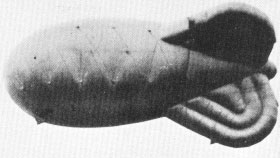 Click for Site Directory
Click for Site Directory
Some
Notes on No.912 Balloon Barrage Squadron
In April 1940 quite a few Balloon Barrage Squadrons were considered to be fully operational and as we had the British Expeditionary Force
disembarking at French ports. It was announced that two Squadrons had been uprooted from their British war sites and sent to France to
protect the disembarkation ports. In January 1940 No. 912 Balloon Barrage Squadron was carrying out routine balloon work at the Grange, Erdington.
It was ordered to prepare for overseas service in France and was first British Balloon Barrage Squadron to arrive in France.
On the 25th January 1940 Flight Lieutenant Grove, D.S.C., and Aircraftman 2nd Class Dainty, left the snow bound Squadron in a Staff Car and
sailed for France as the first members to make up the Advance Party to France.
For many men in the Squadron it was a sudden realisation that they were shortly to go to France.
On 30th January 1940 the list of men for overseas posting was issued. No. 913 Barrage Balloon Squadron was given instruction to start taking over
sites previously staffed by men from No. 912 Balloon Barrage Squadron.
The remnants of men from No. 912 Squadron who were not listed for overseas service were reformed into No. 954 Balloon Barrage Squadron.
The bulk of the No. 912 was sent by road to No.5 Centre to be made into a two Flight Squadron for overseas service.
On 3rd February 1940 the first tranche of men were sent on Embarkation leave.
Four days later the first men left for France. On 10th February 1940 the main Convoy left No. 5 Centre with 19 Winches, 5 Crossleys,
6 Light Vans, 1 Ambulance and 6 Motorcycles. On 10th January 1940 just after midnight the men marched to Sutton Coldfield Railway Station
and entrained and arrived at Dover at 10.00 hours. They sailed on the Ferry at 13.30 hours and arrived on the shores of Dunkerque at
18.00 hours in a raging blizzard. The equipment was unloaded in terrible conditions and the men billeted in the Station Restaurant and
nearby Barracks. On 16th February the Squadron was at Boulogne. The new Headquarters were set up at 124 Rue de Beau.
Thirteen men were admitted to the 16th General hospital on 13th February. Sites were reconnoitred and stores and equipment moved.
The railway wagons containing the huts were emptied and hut assembly begun. Men were still being inoculated on the quay. In bitter weather
the men had to mix by hand sand, cement and gravel to form concrete beds near to the newly erected huts on the sites.
The Staff car was in a collision and two men were injured.
The record between 1st April 1940 and 20th May 1940 do not exist, as on 21st May 1940 the Squadron was bombed day and night
and it was realised that the British forces were at risk of capture from the Nazi forces and on being told the Nazis were just a
few miles away the Adjutant destroyed, by burning, the Cypher books, Code Books, various documents marked “SECRET” and
the Operational Record book. Many of the balloons had been shot down and the order was given to cut all remaining balloons
free, and to get ready to evacuate.
On 22nd May 1940 it was realised that the enemy could be clearly seen some two miles from the Squadron and orders were issue for
an evacuation. The Squadron and all the winches and available vehicles set of for Calais. On 23rd May the convoy parked up and the vehicles,
rations and equipment was handed
over to the Camp Commander at Calais.
At 04.30 hours the men marched to the Quay and at 13.55 hours they boarded the “City of Christchurch” and arrived at Southampton at
14.30 hours on 24th May 1940. They then entrained for Cardington at 16.00 hours and arrived there at 22.00 hours. All officers and men
were sent on leave from 27th May 1940 to 1st June 1940.
They had all had a taste of war and had returned with no loss of life and they could only listen to the radio and read reports
in the newspapers about the terrible events unfolding across the channel and were grateful that they had returned safely
unlike many others who were captured or killed at Dunkerque.
Peter Garwood 2024